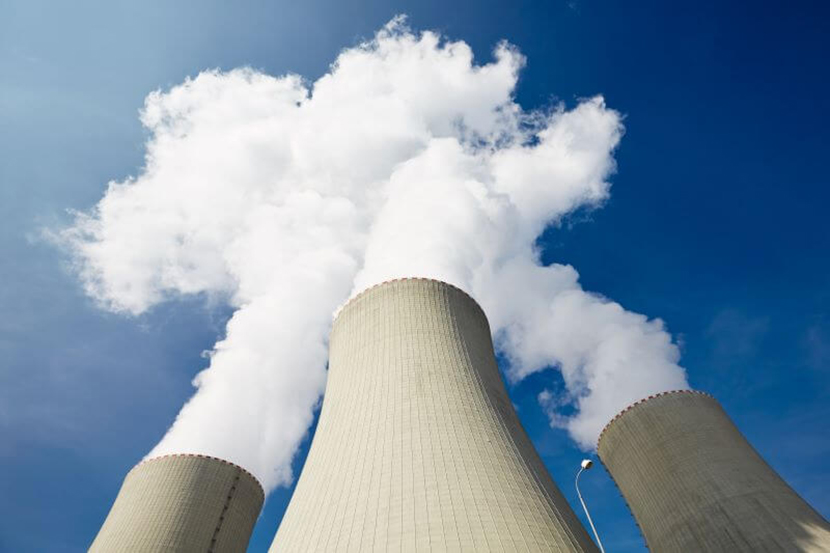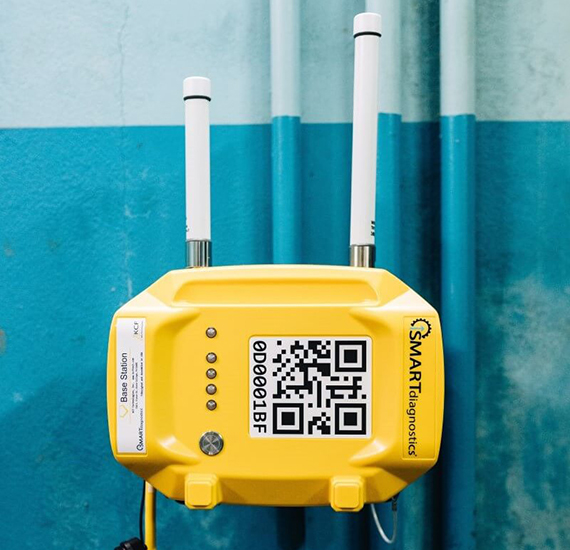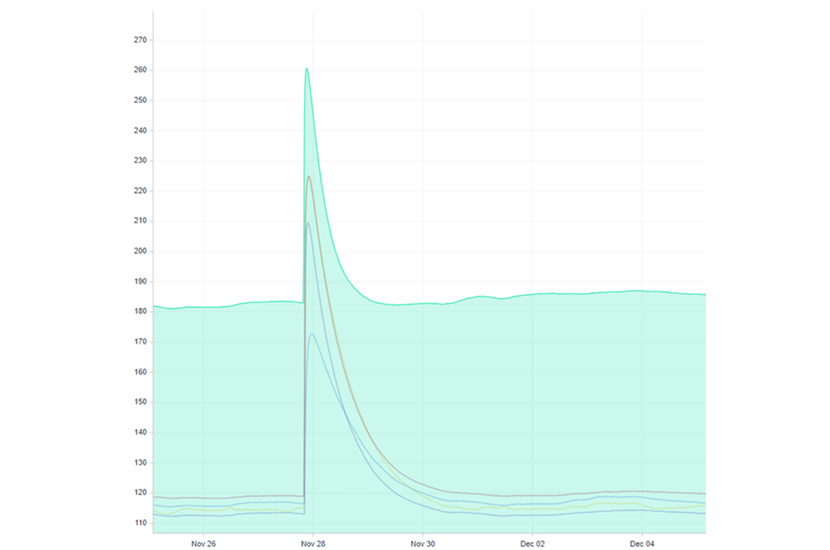
Leveraging Advanced Wireless Monitoring Solutions to Optimize Performance and Minimize Thermal Losses
Introduction
Nuclear power plants use large amounts of water for cooling, with more than half of the energy produced by a nuclear power plant lost as heat. However, accurately tracking thermal output can be a challenge.
Susquehanna Steam Electric Station (SSES), a division of Talen Energy, was tasked with addressing this industry-wide problem and partnered with KCF Technologies to develop a solution. Through a comprehensive hardware and software platform, SSES is already seeing quick wins from its new investment.
Susquehanna Station is a 2-unit Boiling Water Reactor (BWR) station which generates more than 2,500 MW of carbon-free nuclear power outside Berwick, PA. Susquehanna generates enough carbon-free nuclear energy to power 2 million homes and, more recently, an adjacent data campus.
The Project
Talen Energy is a member of the Utilities Service Alliance (USA) and this effort supported the “Advanced Remote Monitoring (ARM) Project.” Talen selected KCF as its technology partner for the Talen activities under the project. The ARM Project is a collaborative effort supported by a grant award through the Office of Nuclear Energy’s Advanced Reactor Development Projects (ARDP) pathway, which gives funds for concepts and ideas that could improve the capabilities and commercialization potential of advanced reactor designs and technology.
The project, originally born in response to the Delivering the Nuclear Promise initiative, promotes a vision that preserving the competitiveness of our nation’s nuclear energy supply can be achieved through the application of advanced technologies. Participating USA members working alongside national laboratories, academic researchers, and leading technology experts, have researched, developed and deployed advanced monitoring solutions across a number of member facilities. The project has enabled automation of data collection, analytics and anomaly detection through intelligent machine learning algorithms, and demonstrates the potential value of real-time operations support through 24/7 remote monitoring and diagnostic services.
The Problem
Susquehanna Steam Electric Station recognized the pitfalls of using a traditional wired predictive monitoring system, which is often cumbersome to manage. They sought an advanced monitoring program that could continuously stream data without relying on extensive wiring. This solution also needed to comply with strict regulations set forth by government regulatory bodies. SSES needed a partner with hardware that could reliably send data in a challenging environment, requiring a flexible and scalable solution.
The Solution
To overcome these challenges, SSES deployed a fleet of KCF Technologies’ V3 Wireless Vibration sensors, Base Station Gateways, IoT HUBS, Analog Adapters, Ultrasonic Sensors, and RTDs (Resistance Temperature Detectors) on their plant equipment. These sensors detect valve leaks by comparing temperature and/or acoustic data to expected values and alert station engineers when deviations are detected. This hardware configuration continuously collects high-resolution data to accurately pinpoint unhealthy conditions or thermal loss issues. Machine health data then streams to KCF Technologies’ cloud-based software, SMARTdiagnostics, where the full spectrum data is interpreted to understand the health of their monitored equipment and get an accurate measure of megawatt output losses. KCF Technologies’ proprietary DART wireless protocol and easy-to-install magnetic sensors allowed the platform to scale quickly without compromising data quality or reliability.
Data security in Nuclear Power plants is critical. Anytime data is sent externally, proper standards must be met to ensure data remains encrypted and confidential. This can cause a challenge in implementing a wireless solution. KCF Technologies has invested heavily in designing our platform with security first in mind. In addition to being ISO 27001 certified, KCF is also SOC II compliant.

Quick Wins
Susquehanna Steam Electric Station’s decision to adopt the KCF Technologies machine health platform has proven to be a game-changer.
Any steam produced in the unit’s reactors that is NOT utilized to drive the Main Turbine-Generators is considered lost generation. Leakage past any steam isolation valve allows small amounts of steam to bypass the Turbine-Generators and that thermal energy is lost to the Main Condensers. The KCF instrumentation has allowed station engineers to quickly and easily identify small steam losses that equate to significant losses in revenue. Early detection is crucial because many of the valves being monitored can only be repaired during a Refueling Outage, which occurs every two years on the Susquehanna Units.
The monitoring has allowed station engineers to identify efficiency losses at or below 1 MW. For reference, 1 MW equates to >17,000 MW-Hours over the two-year operating cycle between refueling periods. This small loss can result in $250,000 to $1,000,000 in lost revenue over that two-year operating period, depending on prevailing energy prices. To date, the on-going partnership with KCF has identified losses on the order of 10 MW, much of which was corrected in the most recent Spring 2024 refueling outage.
An example of the data available to the station engineers is shown below. The station has five Main Steam Bypass Valves that are tightly closed during normal operation but open to control reactor pressure if the Turbine-Generator is offline. Regulations require that these valves be tested periodically to ensure they open when required. The results of a recent test on one of the units (trend plot below) shows a normal, brief opening of each valve as evidenced by the temperature of the piping downstream of each tested valve rising as steam passes the open valve. The piping then cools to its normal, steady-state temperature that should be close to the ambient temperatures near the piping.
As shown on the plot, one of the five valves appears to cool more slowly and exhibits a steady-state temperature on the order of 60 °F higher than the other four valves. The rapid cooling of the piping results from “steam cooling” of the line because the line is under vacuum once the valve closes, and the elevated steady state temperature is due to steam leaking past the closed valve. This valve is now scheduled for repair in the next scheduled Refueling Outage.
The wireless monitoring solution quickly detected a resin valve failure and is being used to schedule condition-based maintenance of resin transfer valves associated with the station’s sixteen Condensate Demineralizers (twenty-four valves per unit).
Although many redundancies exist due to the criticality of Nuclear Power generation water quality being supplied to the Nuclear Reactor Vessel, if a valve failure did occur, the consequences can cause issues downstream in system processes and excursion in water chemistry that may require the unit to lower power or come offline. The site reported that this critical issue was caught two years earlier than it would have been without the KCF Technologies predictive maintenance solution and is allowing valve degradation to be identified before leakby affects water quality. Implementation of condition-based maintenance on these valves has allowed for continued, timely maintenance on the existing valves rather than implementing expensive modifications to install a different style of valve.

By identifying and addressing this problem in its early stages, the plant could schedule maintenance before the issue could progress to failure. When these types of problems are caught in the early stages, the plant can implement maintenance activities BEFORE the conditions become consequential to the reliable operation of the plant. This collaboration demonstrates the potential of the wireless solution to prevent unforeseen breakdowns and enhance the overall reliability of power plant operations.
Conclusion
Susquehanna Steam Electric Station’s partnership with KCF Technologies underscores their unwavering commitment to improving operational efficiency and delivering clean, reliable energy to homes across the region. By embracing innovative wireless solutions, SSES sets new benchmarks in power plant monitoring and management.
KCF Full Guide
Learn more about gaining a competitive edge with the most advanced, comprehensive machine health optimization platform.